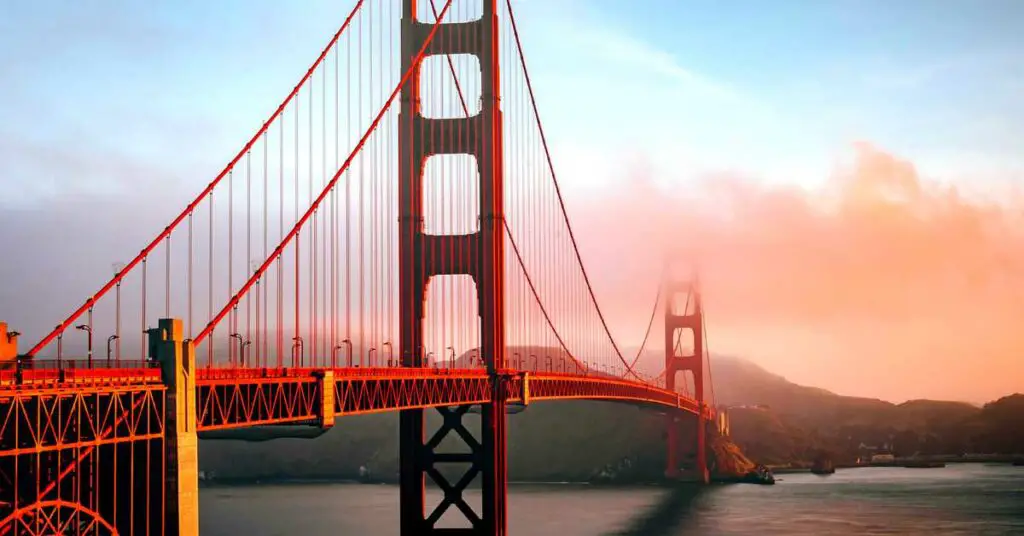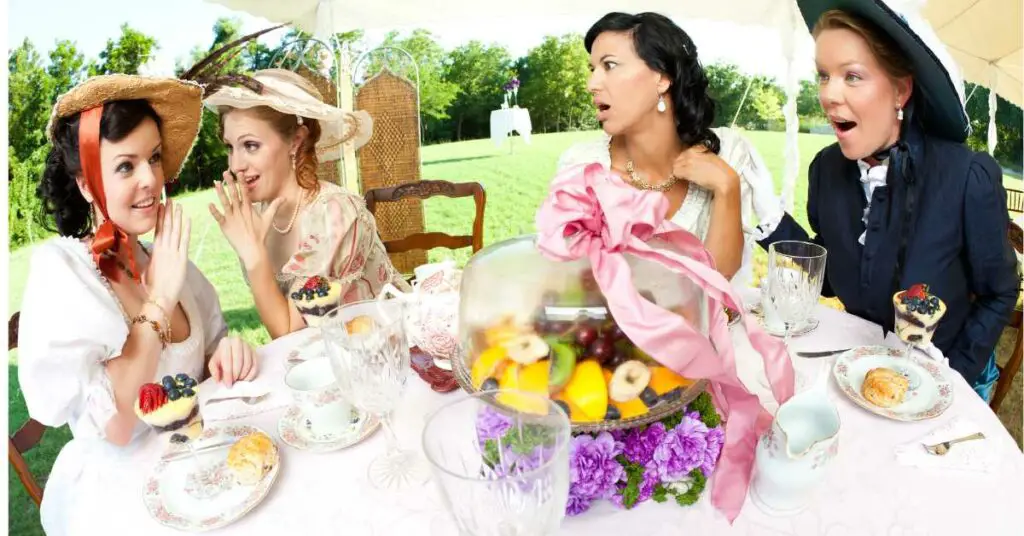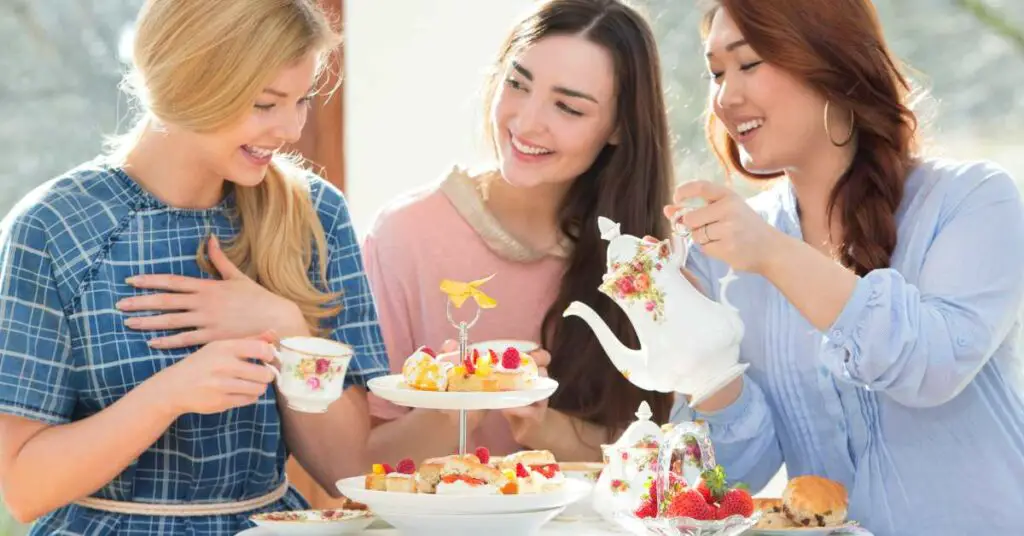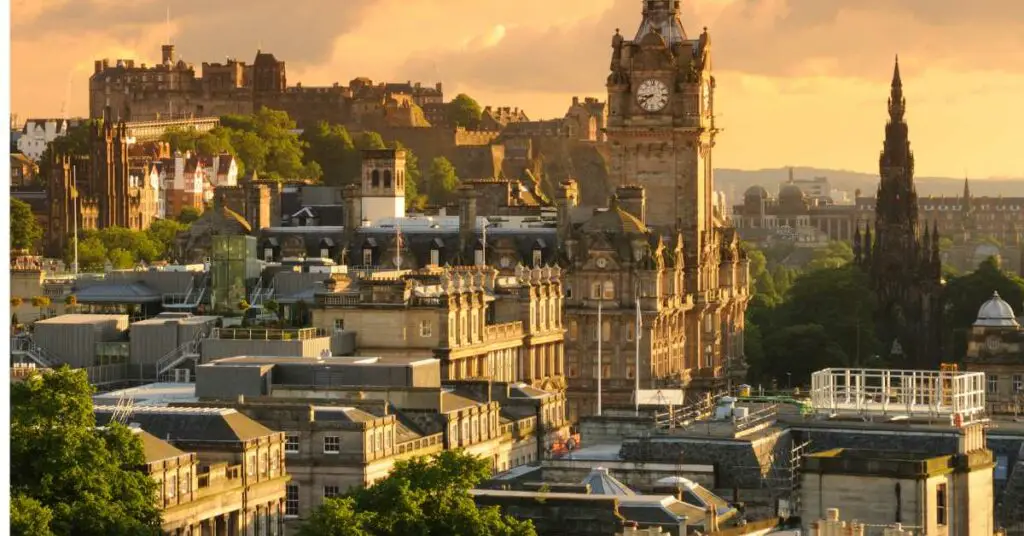Welcome, tea enthusiasts and curious minds, to a delightful journey through the fascinating world of “High Tea vs. Afternoon Tea”!
Today, we’ll unravel the age-old mystery of these two charming tea traditions and spill the tea on what makes them so uniquely delightful.
High Tea and Afternoon Tea are distinct tea-time traditions with different origins and customs. High Tea is a hearty meal for the working class, enjoyed in the early evening, while Afternoon Tea is an elegant midday affair for the elite, featuring delicate treats and refined settings. Both celebrate the art of tea and social interaction.
Imagine, back in the day, when tea was more than just a casual drink. It was a symbol of social status, a break from the day’s hustle, and sometimes even a hearty meal for the hardworking folks. Yep, tea was serious business!
But fear not, dear reader! We won’t just be dwelling in the past. Oh no, we’ll whisk you through history and straight into the modern world, where tea traditions have evolved, adapted, and become Instagram-worthy trends!
So, hold on to your tea leaves, my friends. As we embark on this journey, you’ll soon realize that it’s not just about tea, it’s about traditions, history, culture, and of course, that heartwarming feeling you get when you share a cup of tea with good company.
In the next section, we’ll dive right into the essence of what makes High Tea and Afternoon Tea tick. Get ready to have your taste buds tantalized and your curiosity piqued. Until then, keep those pinkies down and those smiles up – the tea adventure has just begun!
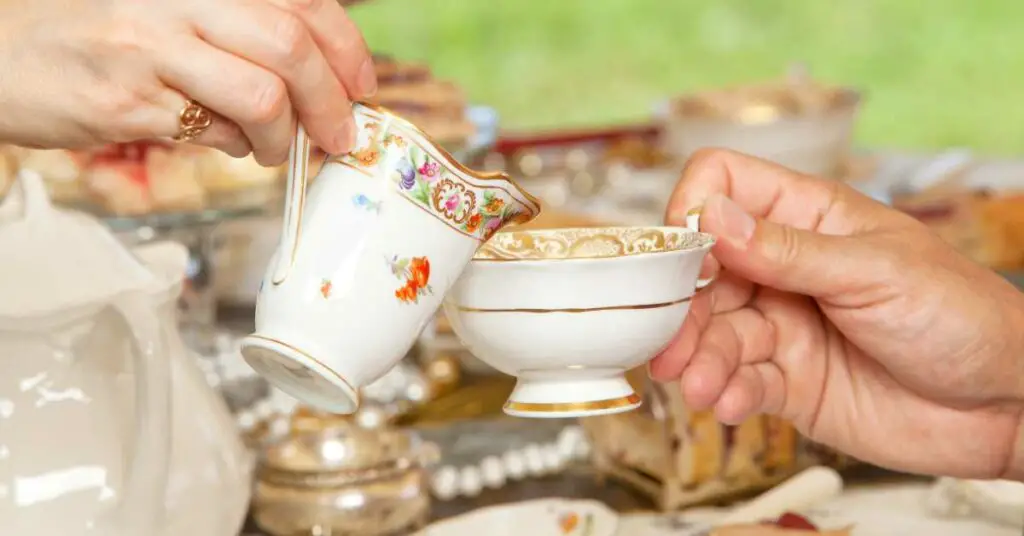
What is High Tea and Afternoon Tea – Brewing the Basics
All right, tea enthusiasts, it’s steeping time! Before we sip our way into the nuances of High Tea and Afternoon Tea, let’s take a moment to brew the basics and understand what these delightful traditions are all about.
Tea Traditions, Defined
High Tea and Afternoon Tea might sound like they belong in the same teapot, but oh, they couldn’t be more different! These two tea-time experiences have distinct origins, cultural significance, and even the time of day they’re best enjoyed.
High Tea: Heartiness on a Plate
Contrary to popular belief, High Tea isn’t about sitting in a posh lounge, sipping tea with your pinky up.
Oh no, it’s all about hearty fare and satisfying the growls in your belly! In the bygone days of the 19th century, when tea was becoming all the rage in Britain, the working class needed a filling meal after a long day of labor. And thus, High Tea was born.
Imagine this: imagine the working-class folks, toiling away in factories and fields, coming home to a spread of goodness. Think savory pies, meat dishes, bread, and butter, all washed down with a strong cuppa – that’s what High Tea was all about. It was a proper sit-down affair, served at a higher table (hence the name) and often as the evening meal.

Afternoon Tea: A Victorian Delight
Now, fast forward to the elegant and ever-so-refined Victorian era. The upper crust of society needed an excuse to socialize and, of course, show off their impeccable manners. And thus, Afternoon Tea emerged as a sophisticated affair, fit for royalty and the elite.
Here’s the scene: ladies in their fancy gowns, gentlemen in their suits, all gathered for a leisurely afternoon soiree. Delicate finger sandwiches, scones with clotted cream and jam, and an assortment of dainty pastries graced the tea table. And let’s not forget the finest china and silverware, making it a truly elegant experience.
The Tea Connection: A Unifying Thread
Now, let’s talk about the star of the show – the tea itself! Both High Tea and Afternoon Tea share a love for this aromatic infusion, but they have different preferences when it comes to tea selection.
In High Tea, you’d often find robust black teas like Assam or English Breakfast, perfectly complementing the hearty dishes.
On the other hand, Afternoon Tea leans toward lighter teas like Earl Grey or Darjeeling, allowing the delicate flavors of the treats to shine through. Oh, and the brewing methods? Well, that’s a topic for another time, my friends!
The Verdict: They’re Both Tea-rific!
So, there you have it! High Tea and Afternoon Tea might be as different as day and night, but each holds its charm, history, and delightful flavors.
Whether you crave a hearty meal to satisfy your hunger or fancy an elegant afternoon indulgence, there’s a tea tradition for everyone!
But wait, we’re just getting started on this tea-rrific adventure! In the next section, we’ll travel back in time to explore the captivating origins and historical significance of both High Tea and Afternoon Tea.
Get your teacups ready, folks – we’re steeping into history, one sip at a time!
Meanwhile, if you are wondering about High tea party ideas for adults, you can read all about that in this article I have written.
The Origins of High Tea and Afternoon Tea – Unraveling Tea’s Timeless Tale
Get ready to set your time machines, dear readers, as we embark on a journey back in time to the intriguing origins of High Tea and Afternoon Tea.
It’s a tale of class distinctions, evolving social norms, and, of course, the irresistible allure of tea that shaped these cherished traditions.
High Tea’s Humble Beginnings: A Hearty Meal for the Working Class
Our tea time travels take us to 19th-century Britain, an era of rapid industrialization and bustling factories. Picture the working-class heroes, the laborers, and the miners, who toiled tirelessly all day long.
These hardworking souls needed sustenance, and that’s where High Tea came to the rescue.
As the evening sun began to set, these weary workers would return home famished, craving more than just a simple cup of tea. They yearned for a proper meal to refuel their bodies and fill their empty stomachs.
And so, the concept of High Tea was born – a substantial, satisfying spread that combined tea with heartwarming dishes.
Contrary to what you might think, the term “High” in High Tea doesn’t refer to a fancy affair. Nope, it actually comes from the height of the dining table at which the working-class folks enjoyed their tea and meal.
It was more of a casual, yet hearty, gathering with family and friends, sitting around a taller table.

Afternoon Tea: A Social Affair Fit for Royalty
Now, let’s fast forward to a time of elaborate dresses, grand estates, and horse-drawn carriages – the opulent Victorian era.
The hustle and bustle of industrialization had given way to a more refined and genteel society. As the upper class found themselves with leisure time in the afternoon, a new tea tradition emerged – Afternoon Tea.
Credit for this exquisite tradition is often given to Anna, the Duchess of Bedford, who found herself feeling puckish in the long hours between lunch and dinner.
In a stroke of genius (or perhaps a rumbling stomach), she decided to indulge in some light snacks and a cup of tea to tide her over until dinner. And thus, the Afternoon Tea ritual was born, catching on like wildfire among the aristocracy.
Afternoon Tea became a chance for the well-to-do to show off their best tableware, exchange gossip, and showcase their impeccable manners.
It was more than just a tea break; it was a social affair, a chance to see and be seen. Delicate finger sandwiches, freshly baked scones, and an array of sweet treats filled the tea table, all accompanied by the finest teas the world had to offer.
What Differs Between High Tea and Afternoon Tea – Savoring the Unique Traditions
Ah, the moment of truth – let’s unveil the delightful differences between High Tea and Afternoon Tea! These two tea-time marvels may share a love for the humble tea leaf, but it’s their distinctive characteristics that give them their own distinct flavor.
So, grab your teacups and let’s dive into the delightful details that set High Tea and Afternoon Tea apart:
Timing and Occasion
Picture this – the sun sets, casting a warm glow on the horizon, as the laborers return home, famished and ready for a filling meal.
It’s the perfect time for High Tea! Traditionally enjoyed between 5 and 6 o’clock in the early evening, High Tea was a working-class affair, designed to satiate hunger after a long day of labor.
On the other hand, Afternoon Tea paints a different picture. As the clock strikes four, the upper echelons of society gather in elegant parlors for a luxurious interlude.
Served between 3 and 5 o’clock in the afternoon, Afternoon Tea provided a delightful escape from the day’s activities, offering a chance to socialize, showcase manners, and indulge in delightful treats.
Culinary Offerings
When it comes to the menu, High Tea brings its A-game in the hearty department. Imagine meat pies, casseroles, sausages, and other substantial dishes gracing the table.
The focus here is on satisfying hunger and refueling the body after a day of physical labor. It’s a feast fit for the hardworking heroes!
In contrast, Afternoon Tea takes a different culinary approach. The spread is a delicate dance of finger sandwiches, freshly baked scones served with clotted cream and jam, and a delightful array of petite pastries and cakes.
It’s all about savoring light, sweet treats that elegantly complement the tea and add a touch of refinement to the experience.
Social Etiquette and Setting:
High Tea and Afternoon Tea set the stage for two distinct social experiences. High Tea invites you to gather with loved ones in a more casual and rustic setting.
Picture yourself around a higher dining table, enjoying hearty dishes and engaging in heartfelt conversations with family and friends. It’s a cozy, family-oriented affair that warms both the heart and the belly.
On the flip side, Afternoon Tea is all about stepping into a world of elegance and sophistication.
Held in upscale hotels, tea rooms, or grand estates, it offers an ornate setting adorned with the finest china, silverware, and exquisite table decorations. It’s an opportunity to showcase your refined manners, exchange gossip with acquaintances, and bask in the ambiance of a bygone era.

Tea Selection and Brewing
Tea takes center stage in both traditions, but each has its preferred cast of tea leaves. High Tea favors robust black teas, such as Assam, English Breakfast, or Scottish Breakfast.
These teas are brewed for a longer time, matching heartier dishes and bold flavors. It’s a match made in tea heaven for those who crave a strong and comforting brew.
Meanwhile, Afternoon Tea prefers lighter teas, such as the elegant Earl Grey or the delicate Darjeeling.
These teas are often brewed for a shorter time to preserve their delicate flavors, allowing the food to shine alongside them. It’s the perfect pairing for those seeking a refined and subtle tea experience.
Cultural Significance:
High Tea and Afternoon Tea were born from different social backgrounds and carry their unique cultural significance.
High Tea emerged as a practical and substantial evening meal for the working class in 19th-century Britain. It served as a way to refuel the hardworking laborers and provide a sense of comfort and togetherness after a day of physical exertion.
In contrast, Afternoon Tea was a product of the elegant Victorian era, where leisure time was abundant among the upper class.
It became an opportunity for the elite to showcase their refinement, indulge in the finest culinary delights, and participate in a sophisticated social event that celebrated elegance and grace.
Regional Variations and Modern Adaptations
While these cherished traditions originated in Britain, they have transcended cultural boundaries and found a place in the hearts of people worldwide.
High Tea, once exclusive to Britain’s working class, has now become a global culinary trend, offering modern adaptations and unique experiences in various regions.
Similarly, Afternoon Tea’s popularity knows no bounds, with cultures around the world embracing and adapting it to their own tastes and preferences.
From Japan’s elegant tea ceremonies to America’s creative tea-inspired twists, Afternoon Tea has taken on diverse flavors while retaining its core essence.
So, whether you prefer the robust flavors of High Tea or the delicate elegance of Afternoon Tea, there’s no doubt that both traditions offer a unique and delightful journey into the world of tea culture. Cheers to celebrating tea in all its splendid diversity!
High Tea and Afternoon Tea: Embracing Social Customs and Atmosphere
Social Customs and Atmosphere:
The social customs and atmosphere in High Tea and Afternoon Tea events vary, reflecting the historical origins and intended audiences of each tradition.
High Tea, rooted in the working-class culture of 19th-century Britain, emphasizes a more casual and family-oriented setting.
It is often enjoyed in the early evening, creating a cozy atmosphere for loved ones to gather, share hearty dishes, and engage in heartfelt conversations. In contrast, Afternoon Tea, born in the refined Victorian era, sets the stage for elegance and sophistication.
Served in the mid-afternoon, it offers an upscale ambiance with ornate settings, fine china, and live music, where etiquette and graceful interactions take center stage.
Role of Conversation and Interaction
Both High Tea and Afternoon Tea place significant importance on conversation and social interaction, but their contexts differ.
High Tea’s familial and relaxed setting encourages informal chatter, fostering warmth and connection among family members and friends. The focus is on enjoying each other’s company and savoring a hearty meal together. On the other hand, Afternoon Tea’s refined ambiance promotes polished conversation and graceful interactions.
Guests at Afternoon Tea often engage in more formal discussions, adhering to tea etiquette while appreciating the artistry of the delicate treats and teas.
Impact of Setting and Ambiance
The setting and ambiance play a crucial role in shaping the overall tea experience in both High Tea and Afternoon Tea. High Tea’s rustic and casual environment creates a sense of comfort and familiarity, making it suitable for relaxed gatherings and informal celebrations.
In contrast, Afternoon Tea’s luxurious settings and sophisticated ambiance evoke a sense of indulgence and grandeur, making it ideal for special occasions, celebrations, and refined social gatherings.
The ambiance sets the tone for the tea experience, enriching the enjoyment of the food, tea, and company, leaving guests with fond memories of their delightful tea journey.

Conclusion
In the delightful world of tea culture, High Tea and Afternoon Tea stand as two cherished traditions, each with its own unique charm and allure.
Throughout this tea-infused journey, we have uncovered the key differences and similarities that define these tea-time experiences.
Key Differences and Similarities: High Tea, with its hearty and robust fare, caters to the working class and is enjoyed in the early evening, providing sustenance after a long day of labor. In contrast, Afternoon Tea, known for its delicate treats and elegance, graces the mid-afternoon, offering an upscale affair for the refined elite.
Both traditions, however, share a deep appreciation for tea, fostering a sense of warmth, camaraderie, and the art of conversation.
Cultural Significance and Historical Roots:
Steeped in history, High Tea and Afternoon Tea offer a glimpse into the social fabric of the past. High Tea reflects the resilience and fortitude of the working class, while Afternoon Tea embodies the sophistication and refined tastes of the Victorian era.
From the humblest of origins to becoming global culinary trends, these traditions symbolize cultural heritage, linking generations through the simple act of sharing tea.
Embrace the Diverse World of Tea Culture
As we bid adieu to our tea-time exploration, we encourage you, dear readers, to embark on your own tea adventure.
Immerse yourself in the richness of tea culture, whether it’s savoring a hearty High Tea with loved ones or indulging in the elegance of Afternoon Tea in an opulent setting. Discover the fusion concepts, global flavors, and innovative presentations that modern tea culture has to offer.
In a world that often moves at a frenetic pace, there is solace in the ritual of tea. Let the simple act of brewing a cuppa, sharing a meal, and engaging in conversation transport you to a realm of comfort and sophistication.
As we celebrate the traditions that connect us through time and space, may the world of tea culture continue to unite and delight, one sip at a time. Cheers to the joyous journey of tea and the countless memories waiting to be brewed!
Frequently Asked Questions
Is there a difference between high tea and low tea?
Yes, there is a difference between High Tea and Low Tea. High Tea is a hearty evening meal traditionally enjoyed by the working class, while Low Tea (also known as Afternoon Tea) is a refined mid-afternoon social event for the elite, featuring delicate finger foods and exquisite teas.
What time is British tea time?
British tea time typically refers to Afternoon Tea, which is enjoyed between 3 and 5 o’clock in the afternoon. It is a delightful midday interlude featuring delicate finger sandwiches, scones with clotted cream and jam, and an assortment of sweet treats, all accompanied by a steaming cup of tea.
What time is dinner in Italy?
In Italy, dinner is usually served later than in many other countries, typically starting around 8:00 PM or even later. Italians often enjoy a leisurely meal with multiple courses, savoring the flavors and relishing the social aspect of dining with family and friends.

